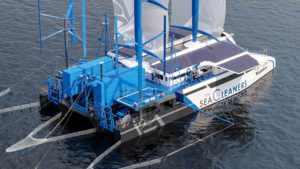Sustainable Marine unveils next-gen platform for tidal energy

Sustainable Marine says it is forging ahead with plans to deliver the world’s first floating tidal energy array after unveiling its next-generation platform in Nova Scotia, Canada.
Construction of the new 420kW PLAT-I 6.40 platform was recently completed at A.F. Theriault & Son Ltd. in Meteghan, Nova Scotia and launched in the Bay of Fundy . . . which experiences the highest tides on earth.
The company says that during testing the system has successfully produced power and has demonstrated it can operate in adverse weather conditions. It is also measuring crucial environmental effects and has not recorded any evidence of adverse impacts on fish or marine animals.
The tidal platform only requires two meters of water for launching and towing and is moored with a turret configuration allowing it to align with the tide or the river flow. It has been designed so it’s easy to install and is accessible for maintenance and servicing, addressing one of the key challenges experienced by earlier tidal energy developers.
This new technology was originally developed in Scotland with support from Scottish Enterprise’s WATERS funding, before arriving in Nova Scotia.
The platform will undergo commissioning and testing in Grand Passage and will then be moved to the FORCE (Fundy Ocean Research Centre for Energy) site as part of the first phase of the Pempa’q In-stream Tidal Energy Project.
It’s expected that the total in-stream tidal energy project will deliver up to nine megawatts of electricity to the Nova Scotia grid.
“This tidal technology is the result of a tremendous international effort combining world-class scientific and engineering expertise from our German, Scottish and Canadian teams, and is the culmination of a decade of research and development,” says Jason Hayman Sustainable Marine’s CEO.
The Pempa’q Instream Tidal Energy project is supported by the Government of Canada with Cdn $28.5m in funding– one of Canada’s largest-ever investments in tidal energy.










